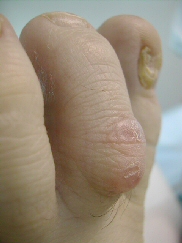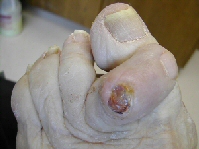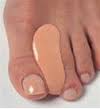Video: How to Treat Hammertoes

Second digit hammertoe
A hammertoe is a toe with a joint permanently buckled downward. It may be flexible or stiff, and may occur on any toe. Hammertoes occur when abnormalities in the function of the foot cause ligaments and tendons to tighten. This results in the toe’s joints bending, cocking the toe upward.
Pain from hammertoes usually occurs when shoes rub on the prominent portion of the toe. The result is inflammation and possibly corns, calluses or ulceration.
There are many effective self-treatment options for hammertoes and you can learn about those here.
Early on in the process of forming a hammertoe, the toe remains flexible, and will straighten when pressure is applied to the buckled area. As time passes, the toe can become permanently contracted and rigid. Painful calluses on the bottom of the foot may accompany rigid hammertoes because of increased pressure generated on the joint due to the contracted toe.
We call most contracted toes hammer toes but they can be defined into 3 areas. Mallet toe – contracted at joint end of toe. Hammer toe – contracted at base of toe. Claw toe – contracted at both joints in the toe. See pictures below.

Hammertoe causing ulcertion
Hammertoes Treatment without Surgery
Our goal is always to treat without surgery if at all possible. We are able to provide conservative treatment for hammertoes in a majority of cases. This can involve:
- Wearing supportive orthotics in shoes. This helps relieve pressure on toe deformities and allows the toes and major joints of the foot to function more appropriately.
- Wearing shoes with more room in the toe box. There are some shoes on the market that provide much more room for hammertoes. You can see our current list of the best shoes for hammertoes here.
- Splints or small straps to realign the toe. You can find out complete list of the best pads plus other home treatments for hammertoes here.
- Trimming or padding corns and calluses.
- Stretching of shoes. To learn about how to stretch shoes or where to get your shoes stretched, you can read our guide to shoe stretching.
OTC Pads and Splints for Hammertoes
There are a number of pads and splints that can help straighten hammertoes while you wear them. They won’t help to permanently straighten the toe but they can do a good job of relieving pain. You can see a complete listing of hammertoe pads here.
Custom Molded Pads and Splints for Hammertoes
For more difficult hammertoes and other deformities we can custom mold a pad or splint for your feet. These devices are made out of a putty like compound and we can make many different kinds depending on the deformity. They are molded directly to your feet and function to reduce or eliminate pressure that causes pain.
The custom foot appliances are soft yet very durable. They are comparable in comfort to silicone based pads. We can make them so that they cushion, align or  separate deformed toes. Besides hammertoes, they can help treat corns and bunions.
separate deformed toes. Besides hammertoes, they can help treat corns and bunions.
The pictures shoe a selection of the different custom toe pads and splints. The custom molded appliances cost between $19 and $30 each and usually last about a year.
Hammertoe FAQs
Conservative treatments do not straighten the toe or correct the deformity. They can, however, relieve pain. In cases where conservative treatment fails, the toes can be straightened surgically. Surgical solutions are usually very effective, but to ensure the best outcomes, it is important that you choose the right surgeon and that the surgeon performs the appropriate procedure. For more information, see the surgery section below.
Are Hammertoes More Common in Women?
Women are more likely to get hammertoes and be bothered by them because they wear smaller, tighter shoes that increase pressure on the toes.
Will Conservative Treatment Straighten a Hammertoe?
While we can usually relieve the pain of a hammertoe conservatively, no conservative treatment has been shown in studies to be effective at permanently straightening a hammertoe. The only way to permanently straighten the toe is through surgery.
What will happen if a Hammertoe is Left Alone?
Generally, hammertoes become worse over time. The bent toe often starts off flexible and eventually becomes stiff. This can cause increased pain both on top of the toe and on the ball of the foot.
How can a Hammertoe be Cured?
The only effective way of correcting the deformity is to have an operation. We still recommend that you try all conservative treatment before considering surgery, but in general the only way to cure a hammertoe is surgical correction. You can learn home treatment options for hammertoes here.
Surgery for Hammertoes
Surgery should be only a last resort treatment for hammertoes. There are times, however, where conservative treatment does not provide adequate relief and surgery is the best treatment option. The information below should provide you with the education you need to make a decision regarding surgery.
Video: Hammertoe Surgery Animation
How does a Hammertoe Operation Work to Correct the Deformity?
There are a number of different operations to treat hammertoes. The three most common hammertoe operations are tendon transfers, digital arthroplasty and digital arthrodesis
- Tendon transfers involve taking the tendon under your toe and moving it to the top of the toe. This results in this tendon acting to pull the toe down into the ground instead of bending the toe. Sometimes this procedure is used alone and sometimes it is used in conjunction with the other two procedures. This hammertoe procedure can leave the toe a bit swollen and stiff.
- Digital arthroplasty involves removing some of the bone from the bent joint. This allows the toe to straighten. An arthroplasty removes half the joint but leaves the joint with some motion.
- Digtial Arthrodesis also involves removing bone from the joint, but once that is done the toe is fused in a straight and rigid position and there is no longer any motion in the toe joint.
In more severe cases, the tendon on the top of the toe along with the joint at the ball of the foot must be released to allow the toe to lie straight. In rare cases, where there is severe stiffness at this joint, then the base of the bone at the bottom of the toe (phalanx) may need to be removed (basal phalangectomy) or the metatarsal shortened (Weil osteotomy).
Which is the Best Surgery to Treat Hammertoes?
It depends on how much your toe is bent, how rigid your toe is and the biomechanics of your foot. Hammertoe surgery can be very complicated because everything that is done to one toe affects the pull of the muscles on the other toes. Dr. Hale is an exceptionally experienced hammertoe surgeon and will discuss the advantages and disadvantages of each procedure with you after examining your foot and your foot function.
Is Hammertoe Surgery Painful?
All surgery results in pain and swelling with the pain usually worse the night after surgery. Anaesthetic techniques and pain killers, however, allow this pain to be well controlled. In general, pain levels vary considerably from patient to patient with some experiencing no significant pain after hammertoe surgery.
Is a General Anesthetic Necessary for Hammertoe Surgery?
Usually not. Most patients are given a medication via IV to make them sleepy and then a local anesthetic is used. Most patients don’t even remember the procedure itself. We always ensure that the patient feels absolutely no pain during the surgery.
How Long is the Hospital Stay?
Most patients are able to have this type of operation performed as day surgery and go home. You are usually at the hospital only for a few hours.
Will a Cast be needed after Hammertoe Surgery?
Plaster casts are usually not required for toe surgery
Are There a Lot of Complications from Hammertoe Surgery?
Every surgery has potential risks and complications. Your surgeon will discuss the risks with you in detail prior to scheduling your surgery. With most foot surgery it is important to understand that that you may still have some pain and stiffness after surgery . It is also important to know that the deformity may reoccur in the future. This is why we recommend surgery only as a last resort after trying all conservative treatment for hammertoes first. If you have a hammertoe but do not have pain or any limitation in activity, we advise that you absolutely do not have surgery. NEVER have hammertoe surgery for purely cometic reasons. The potential for pain afterwards is too great.
We are very careful about making every effort to avoid any complication. Even so, complications can occur. General risks of any surgery include pain, swelling and infection. Some of the specific risks that can occur with toe surgery include:
- Long lasting swelling of the toe. This can even be permanent.
- Return of the deformity or a corn on the toe
- Regrowth of removed bone
- Continued pain in the toe
- A floppy toe
- A Stiff toe
- The toe may not be able to reach the ground (this is called a “floating toe” and is more common with the arthrodesis procedure)
- Pain in other parts of your foot during the recovery period. In general, but not always, this goes away with time.
- A mallet toe deformity may develop over time
When Can a Patient Walk Again and Wear Shoes After Hammertoe Surgery?
Most of the time, you will able to walk using crutches three or four days after toe surgery, but you will remain somewhat limited for about 2 weeks. To keep swelling down we may keep you on crutches after a hammer toe operation for a longer period of time.
Some patients can start wearing wider shoes after 2 weeks with about 60% in shoes at six weeks and 90% in 8 weeks. Arthrodesis procedures take longer to heal and shoes cannot be worn until any wire or pin that is used to support the surgery site has been removed. In general this is about three to six weeks.
Swelling usually starts to decrease around six to eight weeks and the foot will be beginning to feel close to normal at about three months. The entire healing process, however, continues for about one year.
How Long After Hammertoe Surgery Until You Can Drive?
Not until you feel able to perform an emergency stop. In general, this is somewhere between one to two months after surgery. We suggest you also check with your auto insurance company to see if they have any rules regarding foot surgery and driving.
How Long Until A Hammertoe Surgery Patient Can return to Work?
If you are able to get ride to and from work and your job is not active and you can elevate your foot, you may be able to return to work a week or two after toe surgery. In general, patients who must be on their feet at work return to work between four to eight weeks after the procedure depending on the type of job, how active you are and response to surgery.
How Long Until Hammertoe Surgery Patients can return to Athletics?
Although healing continues for up to one year, most patients are able to return to relatively intense athletic activity at around three months. This will depend on the type of surgery you have and how your response to surgery.
How do you Find the Best Hammertoe Surgeon?
Like everything else, some foot surgeons are exceptionally skilled at hammertoe surgery; some are quite bad at it and most are somewhere in-between. To ensure the best chance of a good outcome, it is critical that you find an exceptionally skilled and experienced hammertoe surgeon. On our page on bunion surgery, we outline a number of items to look for in identifying good surgeons and also how to identify surgeons you should avoid. You can find surgeon evaluation information here.
Don’t live with toe pain. If you are experiencing symptoms: call today for an appointment in our convenient Seattle office.
Learn about home treatments for hammertoes here.
Click Here For Self Treatment Hints
